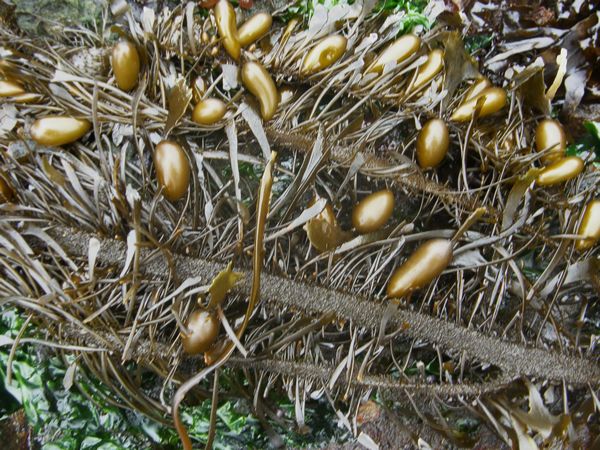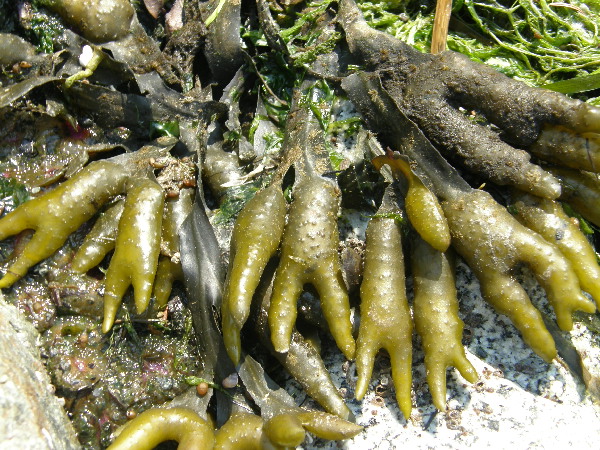|
| |
 |
This olive-green coloured kelp has a wonderful name: Feather Boa Kelp, Egregia menziesii. |
| S |
|
This kelp has a stipe (stalk) that may reach 50 ft/15 m in length. It has a very strong holdfast that may anchor numerous branches.
The blades are short and feather-like, intermingled with bulbous floats of various shapes that keep it afloat. |
| |
 |
|
 |
A curious marine organism you might find attached to the surface of seaweeds is the Kelp Encrusting Bryozoans, Membranipora membranacea. These whitish patches are actually colonies of tiny animals. Sometimes called Sea Mat Bryozoans or Lacy-crust Bryozoans, it is a widely distributed and interesting phenomena. |
| || |
|
|
 |
The Lacy-crust Bryozoans form white colonies in a disc-like shape. The tiny individuals in the colony are called Zooids. They are actually minute animals similar to anemones and have food-catching tentacles. Rectangular in shape, they fit neatly together, separated from one another by tiny walls. As the colony grows outward, the zooids branch into new rows allowing the whole structure to become larger. |
| |
|
Turkish Towel, Chondracanthus exasperatus, is classed as a red algae seaweed and often adds a splash of colour on rocky shores. As it ages however, it loses some of its redness becoming more purple and even black. |
| |
|
The majority of the species of Turkish Towel have bumpy texture covering their flat blades.
In this image you can see how the Turkish Towel is attached to a stone on the beach by its holdfast. |
| |
|
Sea Sac, Halosaccion glandiforme, is a fine example of a bladder-type of algae. It has finger-like bulbous sacs which rise up from its holdfast. It prefers to live on rocky shores in the middle intertidal zone. |
| |
|
There are two similar species of rockweed in the Pacific northwest: Spiral Wrack, Fucus spiralis, (above) and Bladderwrack, Fucus gardneri (below).
To the casual beachcomber, they may appear to be the same species, but a closer look will determine which is which.
Fucus spiralis has a flange like you find on ravioli. This flange rings the inflated branch tips. |
| |
|
Bladderwrack, Fucus gardneri, lacks the flange ring present on Fucus spiralis.
These seaweeds can be found from Alaska down to California.
They prefer wave-sheltered areas |
|
From the mighty Bull Kelp to the miniature zooids, mysteries are revealed on the seashore. Next time you go for a stroll, observe closely and enjoy some of the wonders from the Garden of the Sea. |
| |
|
|
| |
| Dereila Nature Inn Home > Lagoon Trail > Marine Life Guides, Articles, Trivia and More! > From the Garden of the Sea |
| |
|
|
|
Home | All Things Natural Restaurant | Bird's Nest Lounge | Cyber Room | Lagoon Trail | Naturalist's Nook | Wildflower Garden | Woodlands Pathway
Site Map | Inbox | FAQs | News and Updates | Newsletter Information | Games Room | Privacy Policy
All content © Dereila and Sage Innovations
|












